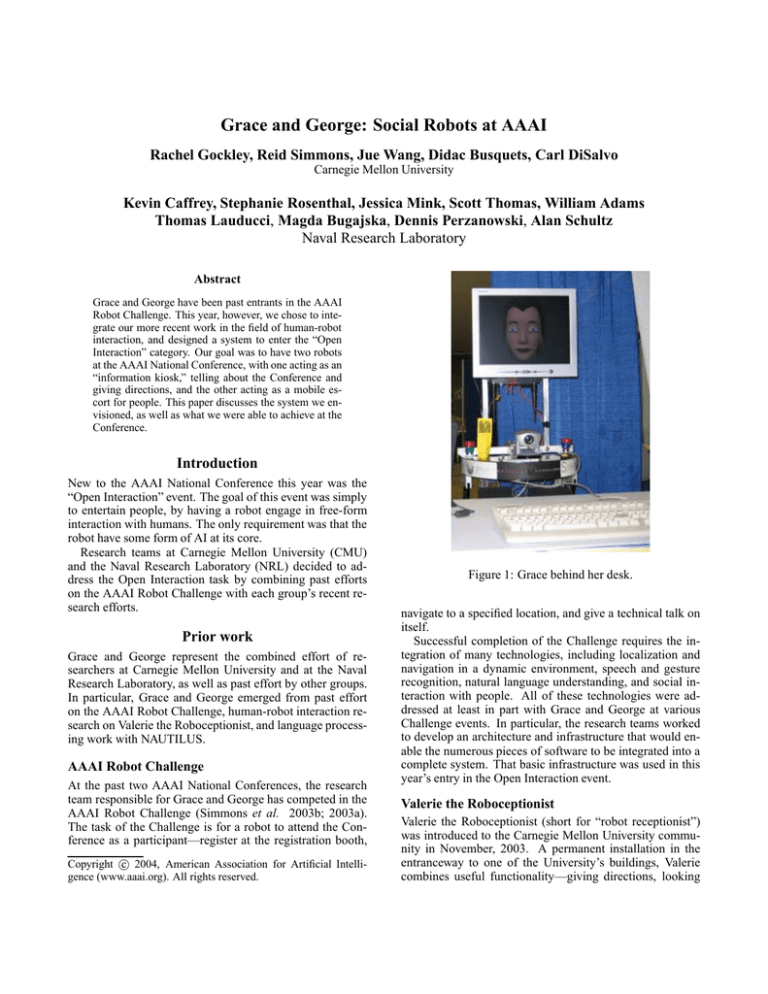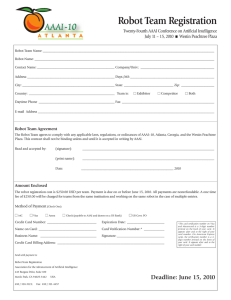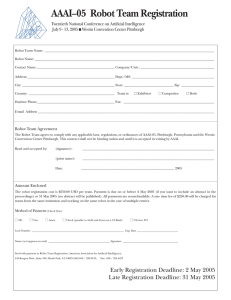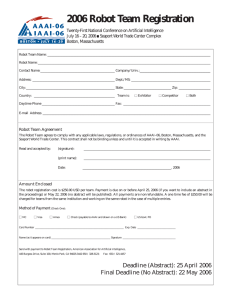
Grace and George: Social Robots at AAAI
Rachel Gockley, Reid Simmons, Jue Wang, Didac Busquets, Carl DiSalvo
Carnegie Mellon University
Kevin Caffrey, Stephanie Rosenthal, Jessica Mink, Scott Thomas, William Adams
Thomas Lauducci, Magda Bugajska, Dennis Perzanowski, Alan Schultz
Naval Research Laboratory
Abstract
Grace and George have been past entrants in the AAAI
Robot Challenge. This year, however, we chose to integrate our more recent work in the field of human-robot
interaction, and designed a system to enter the “Open
Interaction” category. Our goal was to have two robots
at the AAAI National Conference, with one acting as an
“information kiosk,” telling about the Conference and
giving directions, and the other acting as a mobile escort for people. This paper discusses the system we envisioned, as well as what we were able to achieve at the
Conference.
Introduction
New to the AAAI National Conference this year was the
“Open Interaction” event. The goal of this event was simply
to entertain people, by having a robot engage in free-form
interaction with humans. The only requirement was that the
robot have some form of AI at its core.
Research teams at Carnegie Mellon University (CMU)
and the Naval Research Laboratory (NRL) decided to address the Open Interaction task by combining past efforts
on the AAAI Robot Challenge with each group’s recent research efforts.
Prior work
Grace and George represent the combined effort of researchers at Carnegie Mellon University and at the Naval
Research Laboratory, as well as past effort by other groups.
In particular, Grace and George emerged from past effort
on the AAAI Robot Challenge, human-robot interaction research on Valerie the Roboceptionist, and language processing work with NAUTILUS.
AAAI Robot Challenge
At the past two AAAI National Conferences, the research
team responsible for Grace and George has competed in the
AAAI Robot Challenge (Simmons et al. 2003b; 2003a).
The task of the Challenge is for a robot to attend the Conference as a participant—register at the registration booth,
c 2004, American Association for Artificial IntelliCopyright gence (www.aaai.org). All rights reserved.
Figure 1: Grace behind her desk.
navigate to a specified location, and give a technical talk on
itself.
Successful completion of the Challenge requires the integration of many technologies, including localization and
navigation in a dynamic environment, speech and gesture
recognition, natural language understanding, and social interaction with people. All of these technologies were addressed at least in part with Grace and George at various
Challenge events. In particular, the research teams worked
to develop an architecture and infrastructure that would enable the numerous pieces of software to be integrated into a
complete system. That basic infrastructure was used in this
year’s entry in the Open Interaction event.
Valerie the Roboceptionist
Valerie the Roboceptionist (short for “robot receptionist”)
was introduced to the Carnegie Mellon University community in November, 2003. A permanent installation in the
entranceway to one of the University’s buildings, Valerie
combines useful functionality—giving directions, looking
up weather forecasts, etc.—with an interesting and compelling character. Her personality and character were developed through a collaboration with the Drama Department at
Carnegie Mellon. She tells stories of her life, which evolve
over time, to spark interest in her visitors. Similar to George
(Fig. 2), Valerie is a B21r mobile robot with a moving flatpanel monitor mounted on top, which displays a graphical
face. By panning the display, the robot can “look” as much
as 120 degrees to either side. Though the base is mobile,
Valerie remains stationary inside a custom-built booth.
Valerie uses automatic text-to-speech generation to talk
to visitors. Visitors, however, must type on a keyboard in
order to communicate with Valerie. Though speech would
be more natural, keyboard input is easier to control and
is more reliable than speech-to-text systems. Also, due to
Valerie’s placement in a busy hallway, speech recognition
would be severely degraded due to large amounts of background noise.
Aside from telling stories of her life, Valerie can look up
office numbers and give directions to campus buildings. Office numbers are determined through function calls on the
internal network. Directions to the various buildings were
manually generated, and are simply retrieved as required.
The language processing system that Valerie uses is a simplistic rule-based pattern-matching “chatbot,” modified from
Aine (www.neodave.civ.pl/aine). Unlike a robust parser,
Aine is completely ignorant of the way language works, and
it will respond to matched words and phrases without regard
for the contexts in which they are found. On the other hand,
it can handle ungrammatical sentences, sentence fragments,
and even many misspellings, if appropriate rules have been
added to the Aine database.
NAUTILUS
In contrast to Aine, NAUTILUS (Wauchope 1994), the natural language understanding system developed at NRL, produces a so-called “deep parse” from its (text string) inputs,
utilizing syntactic and semantic information from its lexicons. Semantic information is used initially to reduce the
number of possible parses of the input string (Wauchope
1990). An additional module resolves anaphora and quantified noun phrases. Towards the end of processing, a quantified logic expression is constructed (in Lisp) that encodes,
in a general form, the system’s understanding of the input
string. Execution of the expression results in calls to subroutines that correspond to the main concepts named in the
input string, usually by verb of the sentence: move, turn,
tell, stop, continue, etc. These subroutines in turn must
be linked to code supplying the appropriate applicationdependent functionality.
Unfortunately, the performance of NAUTILUS can degrade abruptly in the face of unknown words and sentence
types, though a reasonable guess can be made for the category of certain word types, such as nouns. Furthermore,
adding new grammar rules, and even lexical entries, when
they are of a novel type, can be a time-consuming process.
Unlike Aine, NAUTILUS is designed for results that are precise but of narrow coverage; Aine sacrifices precision for
(relative) ease of coverage.
Figure 2: George with mounted keyboard and printer.
Goals
To address the Open Interaction Event, we decided to build
on our previous research and design two robots, one stationary and one mobile.
Information Kiosk
Drawing heavily on the work done for Valerie, we decided
to have one robot, Grace, act as an information kiosk. The
robot would be stationary behind a desk. People would be
able to approach the robot and interact with it by typing on
a keyboard on the desk. The robot would be able to answer
queries about the Conference and the surrounding area, give
directions within the conference center, and also engage in
idle chat.
Escorting
In addition to the information kiosk robot, we decided to
have a second robot, George, which would have the same
capabilities as the kiosk robot but also be mobile. George
would have the added capability to escort people to their
desired location. When within range of each other, the
two robots would communicate, such that Grace could summon George to escort someone from Grace’s desk, provided
George was not currently preoccupied.
Hardware
Grace (Fig. 1) is built on an iRobot B21 mobile robot, while
George (Fig. 2) is built on an iRobot B21r. Each robot displays an expressive computer-animated face on a flat-panel
LCD monitor. Because George was expected to interact with
people while in free space and while escorting, George’s
monitor was mounted on a pan unit, while Grace’s position
behind a desk allowed a fixed mount. Both robots have builtin touch, infrared, and sonar sensor arrays. Near the base of
each is a SICK scanning laser range finder, which provides a
Figure 3: User input is displayed on the robot’s “head,” directly beneath the face.
180-degree field of view. Both robots have cameras on board
for color tracking, though this capability was not used in the
Open Interaction task.
As with Valerie, both Grace and George required keyboards for user input. Since Grace was to remain behind
a desk, a standard computer keyboard was simply placed
on the desk. To allow George to be mobile, however, a
small keyboard was mounted to the mezzanine of the robot,
a bit below the monitor (Fig. 2). The positioning of the keyboard attempted to take into account both comfortable typing height for most people, as well as a comfortable conversational space.
Both robots were also equipped with small-format thermal receipt printers. These were intended to be used to print
copies of directions for visitors. For Grace, the printer was
just placed on the table. George’s printer was mounted beneath his keyboard, and oriented such that the output from
the printer was redirected above the keyboard, where the visitor could easily take it.
Software Architecture
The basic software architecture follows the same design
that we used in previous years for our entries in the
Robot Challenge. Each robot runs a set of independent processes that communicate via IPC message passing (http://www.cs.cmu.edu/∼IPC). Processes could be independently started and stopped through the Microraptor
system (http://gs295.sp.cs.cmu.edu/brennan/mraptor/).
Much of the software used in Grace and George was
developed previously, either for previous AAAI Challenge
events, or for Valerie. New this year were a modified interface, a “dialogue manager” to handle user input, an improved direction-giver, and escorting capabilities.
Interface
For interaction with humans, both robots display an expressive, animated face on their LCD “heads.” The faces
are used for both emotional expression and for simple gestures (head pointing and directing gaze), since the hardware lacks any conventional manipulators. Each robot uses
the Festival (http://www.cstr.ed.ac.uk/projects/festival) textto-speech system to automatically generate utterances. The
Figure 4: Printed directions from Grace.
process that controls the facial musculature (“expression”)
also performs automatic lip-syncing with the utterances. In
addition, the utterances are displayed in cartoon-styled text
balloons, in order to aid human understanding of the synthetic speech.
Previous appearances of Grace and George at AAAI Challenge events featured a speech interface. However, the
speech-to-text software performed poorly both in noisy environments, and for speakers who had not trained a model
nor were familiar with the bounds of the grammar. As a
result, we decided to remove the speech-to-text component
this year. Replacing this component with a conventional
keyboard allowed Conference attendees to interact with the
robot with much less confusion and misunderstood speech.
To enable visitors to the robots to see what they were typing
without the use of a second monitor (as with Valerie), user
input was displayed, as it was typed, below the face on the
LCD monitor (Fig. 3).
In addition to receiving spoken directions from the robots,
visitors could request directions in printed form. Directions
were then printed on the robot’s thermal printer for the user
to take along (Fig. 4). To reduce paper waste, directions
were only printed for those visitors who explicitly asked for
a printed copy.
Dialogue Manager
The dialogue manager is a finite state machine, which serves
to dispatch user input to appropriate processes, perform
database lookups for certain information, and manage a
small amount of dialogue. Fig. 5 shows the basic architecture. User input is passed to the dialogue manager, which
in turn passes it to the language processing module, which
was built using a combination of NAUTILUS and Aine. The
response from the language processing module is then returned to the dialogue manager. In some cases, the dialogue
manager passes the response directly to the user. Other
times, the response is a query for the dialogue manager to
handle. Depending on the query, the dialogue manager will
either generate a response via a database lookup (for Conference talks and local information), or will dispatch the query
Figure 5: Dialogue Manager architecture
to the direction-giver or the escort module (discussed below).
Our original intent was to use Aine only as a fall-back
module, for inputs that fell outside of the NAUTILUS grammar. However, there may also be sentences that NAUTILUS
can parse and interpret, but still not have a good response for,
because of potential gaps in the application-specific code
that defines those responses. Furthermore, it is much easier to add venue-appropriate pattern/response pairs to Aine,
and so for some classes of inputs we decided to ignore NAUTILUS’s (valid) response, anticipating that it would be more
generic than Aine’s. On the other hand, we also had to
make sure that NAUTILUS’s response would be used, however generic, in those cases where Aine gave only an uninformative default response. During the conference runs,
though, almost all of the input was handled by Aine rather
than NAUTILUS.
Direction Giving
A metric map of the Conference area was generated in advance with Carmen (http://www-2.cs.cmu.edu/∼carmen/),
and used as the basis for a handmade topological map. The
direction giver uses the topological map to find a path and
generate directions from the starting location to the destination. The map is laid out in a graph with vertices representing destinations in the map such as rooms, hallways,
common areas, and points of interest. The edges represent
lengths of paths that connect each destination on the map.
In addition, the graph incorporates distance between points
and angles between connected points to assist in direction
generation.
In an enclosed environment, the direction giver can easily
generate directions by referencing intersections of hallways
and different hallways to turn down. In an outdoor environment, there are not as many objects or paths that are easily
referenced. Therefore, points that represent landmarks, such
as a flag pole or a clock tower, are given special landmark
weight values. This allows the direction giver to give accurate directions in ambiguous environments by guiding the
user according to the landmarks.
The direction generation algorithm works as follows. A
path is found through the map by using Dijkstra’s shortestpath algorithm. An initial pass is made down the entire path,
splitting it into segments of straight paths. The assumption
here is that humans give directions by telling each other to
go down a certain segment of the path in a certain way, and
then how to transition to the next segment of the path. Basic
data, such as which way to turn, whether segments of the
path go through ambiguous environments, and what landmarks to use to guide the user, are also collected during the
pass. Directions for the different segments of the paths and
directions for transitioning from one segment to another are
generated on the fly during the first pass. Finally, the directions for the various segments are combined, and redundancies are cut out.
Translation of directions into spoken English relies on the
distances and relative angles between points, as stored in the
augmented topological map. When traversing the nodes to
generate spoken directions, direction changes such as “turn
left” or “make a slight turn right” were output based on the
angle.
Escorting
The goal of the escort module was to respond to escort requests by determining whether the robot was currently free
to escort someone, and if so, leading that person to his de-
sired destination. This would require negotiating with the
person, possibly moving to meet the person at a known location, tracking the person while navigating, and modifying
the robot’s speed as necessary so as not to lose the person.
The navigational tasks required for escorting were addressed in previous AAAI Challenge events with Grace and
George. These tasks include map generation, dynamic localization, path planning, and navigation, and all were reused
for this event with little modification.
For person tracking, we decided to simplify the task to
tracking a colored hat that we would provide to the escortee. We developed a tracker based on the Swarthmore Vision
Module (SVM) (Maxwell et al. 2002). The person tracker
was designed to set the robot’s maximum velocity based on
how far away the person was—if the escortee lagged behind,
then the robot would slow down to accommodate him. Unfortunately, due to time constraints, the people-tracker was
not fully integrated into George (see below).
Visitors would be able to ask the escort robot directly to
be lead to a destination. In addition, we wanted that visitors could ask for an escort from the information kiosk. To
handle escort requests in this way, the kiosk robot would attempt to contact the escort through the wireless network. If
the escort was out of wireless range, the kiosk could immediately report that the escort was unavailable. Otherwise,
the escort would compute approximately how long it would
need to return to a common meeting point (including time
to finish a current escort task, if applicable), and send that
time as a response to the kiosk. The kiosk could then ask the
requesting person whether he wanted to wait that long, and
send the response back to the escort.
Performance at AAAI
Grace was stationed behind a desk labeled “Information” for
a significant portion of the Conference (about two full days).
Much of her interactions with the public was comprised of
‘small talk’ about her origin and capabilities. She could also
engage in conversations like the following, providing information on local restaurants, and how to find them:
> where is mexican food
speak(“There is a restaurant called Chacho’s about half
a mile away.”) speak(“Would you like the address?”)
> yes
speak(“The address for Chacho’s is”) speak(“18 S
Almaden Ave San Jose, CA 95113”)
> print that please
speak(“Please take the directions”)
> next one
speak(“There is a restaurant called Pedro’s Restaurant
& Cantina a few miles away.”) speak(“Would you like
the address?”)
> no
speak(“Ok”)
In another example of interaction, Grace consults the
Conference talk database and map to guide an attendee to
the requested talk:
> what is your name
speak(“I am Grace.”)
> what is your last name?
speak(“I don’t have a last name. Computers have more
efficient ways of addressing each other.”)
> what is a good chinese restaurant
speak(“There is a restaurant called Pagoda Restaurant
about half a mile away.”) speak(“Would you like the
address?”)
> yes
speak(“The address for Pagoda Restaurant is”)
speak(“170 South Market St San Jose, CA 95113”)
> where is manuela’s talk
speak(“Manuela Veloso has a talk in room A8.”)
speak(“Would you like directions?”)
> yes
speak(“Turn left. Go straight across the registration
areaTurn right.”) speak(“Turn left. Go straight down
the concourse.”) speak(“A8 will be the first meeting
room on the left.”)
(Unfortunately, the last response also shows a text generation bug: an errant “Turn right” appears in the string.) All
but one of the input/output pairs were handled by Aine rather
than NAUTILUS.
The team’s official “demo” time was near the end of
the Conference. Because escorting was still not fully integrated, we stationed George outside of the exhibition hall,
running the same “information kiosk” version of the software that Grace used. Some people even noticed that
George and Grace were responding similarly to similar
questions, and were disappointed not to see distinct behaviors. Nonetheless, George attracted a significant number of
people throughout the day (Fig. 6), just as Grace did, at least
at the start of the Conference. Because the researchers were
still integrating components of the system as the Conference
was starting, testing was ongoing, and Grace did show multiple periods of unresponsiveness, due to bugs in then Dialogue Manager and the “expression” process. Even then, we
often noted a large number of people attempting to interact
with her. Fewer people were approaching her toward the end
of the Conference, though, possibly as a result of her earlier
unresponsiveness. People often approached in groups, rather
than one at a time.
George attempted one escort run during the Conference,
at the request of a person interacting directly with George.
George began escorting that person to the Exhibit Hall, but
was unable to complete due to a steady stream of people
blocking the door into the Hall. Also, because the peopletracking algorithm was never fully integrated, when George
was escorting someone he was not watching where that per-
following the periodic unresponsiveness she exhibited earlier.
Finally, we note that we ended up using NAUTILUS
much less than we had expected. At first, the idea of using Aine purely as a fall-back system seemed very natural,
knowing that it has a low precision rate. But we failed to
take into consideration how much faster it would be to add
venue-specific behaviors to Aine, rather than NAUTILUS.
References
Figure 6: George interacting with a group of people.
son was nor trying to maintain a proper lead.
Discussion
Clearly, the system we envisioned suffered greatly due to
a time crunch, resulting in reduced functionality from what
we had planned (with escorting in particular) and in reduced
reliability in the parts of the system that were put into place.
However, we did learn several important things from the experience.
One thing we learned is that multi-institution software integration takes time. This is fairly obvious and well-known,
but yet it was our largest problem this year (as with previous
years).
Also, robotic kiosk systems must be extremely robust;
otherwise, the public will tend to become annoyed and/or
disinterested. We believe we saw evidence of this in the (apparent) reduced interest in Grace later in the Conference,
Gockley, R.; Bruce, A.; Forlizzi, J.; Michalowski, M.;
Mundell, A.; Rosenthal, S.; Sellner, B.; Simmons, R.;
Snipes, K.; Schultz, A.; and Wang, J. 2004. Designing robots for long-term social interaction. Submitted to
ICRA2005.
Maxwell, B. A.; Fairfield, N.; Johnson, N.; Malla, P.; Dickson, P.; Kim, S.; Wojtkowski, S.; and Stepleton, T. 2002.
A real-time vision module for interactive perceptual agents.
Machine Vision and Applications.
Simmons, R.; Bruce, A.; Goldberg, D.; Goode, A.; Montemerlo, M.; Roy, N.; Sellner, B.; Urmson, C.; Schultz,
A.; Adams, W.; Bugajska, M.; MacMahon, M.; Mink, J.;
Perzanowski, D.; Rosenthal, S.; Thomas, S.; Horswill, I.;
Zubek, R.; Kortenkamp, D.; Wolfe, B.; Milam, T.; and
Maxwell, B. 2003a. Grace and George: Autonomous
robots for the AAAI robot challenge. Workshop paper for
AAAI 2003.
Simmons, R.; Goldberg, D.; Goode, A.; Montemerlo, M.;
Roy, N.; Sellner, B.; Urmson, C.; Schultz, A.; Abramson,
M.; Adams, W.; Atrash, A.; Bugajska, M.; Coblenz, M.;
MacMahon, M.; Perzanowski, D.; Horswill, I.; Zubek, R.;
Kortenkamp, D.; Wolfe, B.; Milam, T.; and Maxwell, B.
2003b. Grace: An autonomous robot for the AAAI robot
challenge. AAAI Magazine 42:2:51–72.
Wauchope, K. 1990. A tandem semantic interpreter for
incremental parse selection. Technical Report NRL-9288,
Naval Research Laboratory, Washington, D.C.
Wauchope, K. 1994. Eucalyptus: Integrating natural language input with a graphical user interface. Technical Report NRL/FR/5510-94-9711, Naval Research Laboratory,
Washington, D.C.





